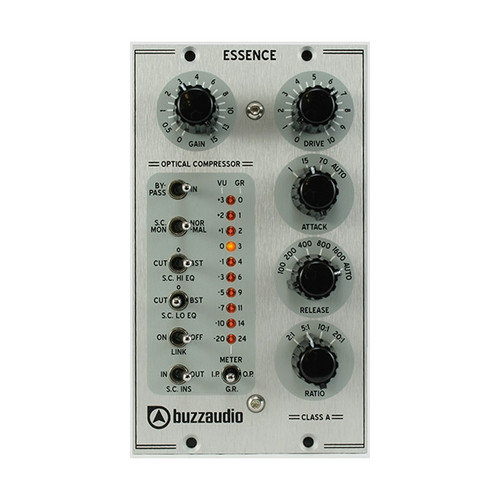audio path color
The most well known audio compressor that uses a diode bridge as the gain reduction element would have to be the Neve 2254 (and Hugh Robjohns at SOS Magazine provides a great insight to the workings of the diode bridge in his review here). The DBC is not a copy of the 2254 - but it is the inspiration for its design. The audio path features our own Class A discrete BE41 amplifiers in a balanced configuration throughout, and for extra colour, we have a custom "radio steel" laminated transformer coupling into the diode bridge. This combination produces a vintage character that can best be described as tight, colourful and rich with harmonics!
dynamic ratio power
Our unique side chain design re-creates the style of compressors from the 60's (think Fairchild) whereby the compression ratio is progressively increased with deepening gain reduction. So as the input signal increases past threshold, the ratio will vary from 1:1 right up to 15:1. This feature allows for the control of very dynamic signals (such as vocals) in a seamless fashion and is also a very desirable characteristic when used on complex percussive material such as the drum buss and drum loops. On the mix buss the DBC-20 adds perfect analog colour to "in the box" mixes.
operational ease
This compressor is easy to get happening with six switched attack and release times covering a wide range, including an interesting auto release mode. Big knobs are provided for the amount of compression and the output gain control. The compressor can be switched to a Soft mode whereby dynamic peaks are partially retained. Another switch introduces a high pass filter to the side chain to lower compression sensitivity at low frequencies which is useful on the mix bus. The large knobs with pointers allow for accurate resetting of the compressor and the fast response 15 LED bar graph meter accurately displays gain reduction.
affordable price
The lower cost of the DBC-20 is not achieved by using cheap parts, instead with clever design we have reduced the amount of time it takes to assemble and align each unit. And everything is assembled right here in our boutique New Zealand workshop with human hands.
Features
- GAIN - variable pot that adds gain at the output to correct for lost level with 15dB range.
- COMPRESSION - variable pot that sets the amount of compression.
- ATTACK - rotary switch with 6 settings, FAST (less than 0.5mS)-5mS-10mS-15mS-25mS-50mS.
- RELEASE - rotary switch with 6 recovery time settings, 50mS-100mS-200mS-400mS-600mS and AUTO.
- HARD/SOFT - adds dynamics in soft mode for times when very light compression is required.
- FLAT/BASS - reduces compression sensitivity at low frequencies for more bass punch, approx 8dB at 100Hz.
- BYPASS/ENGAGE - hard wire unit bypass to compare compressed and uncompressed signals.
- There is also a handy power ON/OFF switch and the LINK A/B which provides for stereo tracking to prevent image shift when used on the mix buss.
Specifications
- Maximum Input Level; +27dBu
- Maximum Output Level; +27dBu
- Noise; -80dBu (measured A Weighted with 10dB gain applied)
- Gain; variable 0dB to +15dB
- Frequency Response; 6Hz to 400kHz measured no gain reduction
- Harmonic Distortion; At +10dBu input level, no gain reduction; 0.28% @ 100Hz, 0.25% @ 1kHz, 0.15% @ 10kHz
- Harmonic Distortion; With 10dB gain reduction (Release set to 400mS); 1.5% @ 100Hz, 0.5% @ 1kHz, 0.5% @ 10kHz
- Standard Operating Level; +4dBu
- Size; 1 Unit 19" rack mount, (482Wx44Hx250D)
- Power requirements; 230V/115V selectable, IEC detachable power cable.
- Specifications are typical of a production unit and are subject to change without notice.
- 0dBu reference = 0.775 volts RMS.

















